
The pump technology selected for an application will depends on many different factors including fluid type, viscosity, abrasiveness and temperature among other. However, when it comes to lubrication oil pumps, a positive displacement type is always used.
In this blog, we’ll look at why this is, while taking a closer look at how positive displacement pumps work. Read on to learn more.
What is a positive displacement (PD) pump and how does it work?
The main reason why lubrication oil pumps are always PD pumps is because this type of pump is engineered to make sure any pumping activity is only forward. The internal design of a PD pump can ensure and prevent fluid from being able to recirculate back to the pump inlet, or inside its casing.
PD pumps also offer three vital-to-lubrication oil pumps. They can provide a fixed volume of oil transferred each revolution, constant pressure and a flow rate in proportion to speed.
To explain the operation of a PD pump simply, it works by drawing oil into a chamber through creating a vacuum. After the cavity is full, the pump cycles cause the oil present inside the pump head to rise in pressure. As a result, the oil is then discharged through the discharge port and sent to where it is required.
What are the benefits of PD pumps?
Positive displacement pumps are chosen for the various advantages they offer to lubrication oil pumps.
For instance, PD pumps deliver accurate and predictable flow. As chambers in PD pump designs have a fixed volume, oil flow is always proportional to speed. Therefore, highly accurate calculations can be made regarding the flow issued per revolution. This allows companies to use the precise level of lubrication required for effective equipment operation, while mitigating waste.
PD pump designs are also unaffected by the viscosity of oils. This means that should viscosity increase due to temperature; equipment operation is never impacted. PD pumps also operate at reduced speeds in comparison to centrifugal pumps. Their lower speeds enable them to handle a wide range of oils increasing protection from wear. Additionally, unlike centrifugal pumps they can also delver constant pressure levels that are much higher than the duty point.
In summary, due to their forward pumping action and multiple benefits, positive displacement pumps provide the ideal solution for lubrication oil pumps.








































